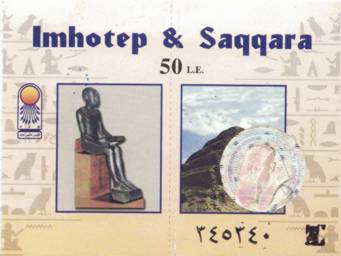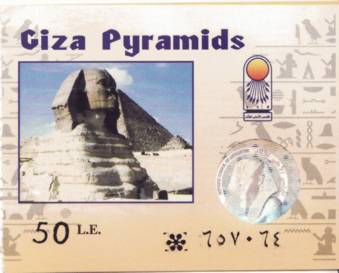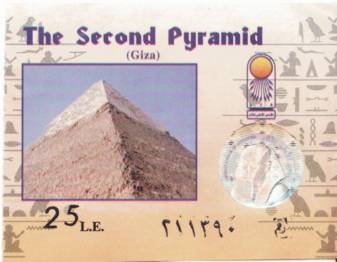يوم الجمعة، ١٦ ربيع الثاني ١٤٢٨
| 20 | ٢ | |||
| 21 | ٣ | |||
| 22 | ٤ | |||
| 23 | ٥ | |||
| 24 | ٦ | |||
| 25 | ٧ | |||
| 26 | ٨ | |||
| 27 | ٩ | |||
| 28 | ١٠ | |||
| 29 | ١١ | |||
| 30 | ١٢ | |||
| 1 | ١٣ | |||
| 2 | ١٤ | |||
| 3 | ١٥ | |||
| 4 | ● | ١٦ | ||
| 5 | ١٧ | |||
| 6 | ١٨ | |||
| The Pyramid Fields |
... But it arrived in Cairo an hour late. This was no problem for us, though: We just hopped a taxi to our hotel and were able to check in early. The same driver offered to take us around to sites all day for LE 150 ($26.40), and the price was so good I didn't even haggle.
 |
Saqqara |
We started the day at ![]() EGY Men-nefer
EGY Men-nefer
Memphis is important also in that it is, indirectly, how the exonym "Egypt" came to our language: The historian Manetho wrote of Memphis as ![]() EGY km.t
EGY km.t
| World Heritage Site | ||||||||||||||||||||||||||||||||||||||||||||||||||||||
|
||||||||||||||||||||||||||||||||||||||||||||||||||||||
First at Saqqara, I explored the New Tombs. To be completely frank, I didn't know quite what I was looking at, and they weren't quite as beautiful inside as those at Deir al-Medina – but they were complexly arranged and had some interesting statuary, which made me feel better about missing the convoluted-but-probably-inaccessible tombs of the Valley of the Kings (which we bypassed for the Valley of the Queens because the kings' tombs are known for being closed most of the time for archaeological research). This was the point in the trip when we were feeling most overwhelmed by "pharaoh fatigue" (the Egyptian variation on "ruin fatigue") – and I really just walked through, perceived it, and hoped that I could reassemble the memory into a coherent recollection later. I'm pleased to say that I did. But I'm embarrassed to acknowledge my failure at the time, which led to slipshod and inadequate photography. Pictures were forbidden, of course, in the tombs (although the caretaker made it clear that for the right amount of baksheesh I could photograph to my heart's desire; I declined his offer).
|
|
Then we walked into the pyramid complex of 
|
|
You'll note that the entrance ticket refers to "Imhotep & Saqqara," which may lead you to wonder, "Where is Imhotep?" But the accurate question is not "where?" but "who?" (although "where?" is not completely inaccurate, as his tomb has not yet been found). 
Chancellor of the King of Lower Egypt
First after the King of Upper Egypt,
Administrator of the Great Palace,
Hereditary Nobleman,
High Priest of Heliopolis,
Builder,
Chief Carpenter,
Chief Sculptor, and
Maker of Vases in Chief
(That last bit about the vases reminds me that I need to clean some of the older stuff off of my résumé.)
After Saqqara we returned to the taxi to go north to Giza, on the way to which we passed an alabaster factory (where they exhibited an uncommonly low-pressure sales technique) and some of the interesting facets of Cairene traffic.
|
|
 |
Giza |
At 


The View from the Cafeteria |
And let me tell you – this place was amazing! I was surprised to think so at the time, and I'm surprised to write it here, because (1) I've already acknowledged our "ruin fatigue" issue and (2) most people are not blown away by the pyramids, saying that they are too familiar through a lifetime of pictures to make a great impression in person. Maybe I was just getting a "second wind," but to me it was profound. And especially interesting in its proximity to the suburbs of Cairo, which are literally (and I do not misuse the word "literally") across the street; conceivably, you could rent an apartment in Cairo and have the Sphinx stare into it for eternity – and somebody probably does.
The Sphinx, known in Arabic as
|
|
We could have waited for the 1:00 PM admission to the Great Pyramid, but opted to go into the Pyramid of Khafre instead as it stayed open all day.
|
|
I still can't decide if I made a mistake in choosing Khafre over Khufu. The walkways inside Khufu appear far more elaborate on cross-sections, and it is the "Great" pyramid – but that "great" thing has been a little bit bogus for several centuries: Today it stands 138.8 m (455.2'), almost 8 m lower than its original height of 146.6 m (480.9'); so in 2007 Khafre, with its limestone "magic shell" still intact at the top, stands taller at 143.5 m (471'). And you don't go to the top, anyway. You'll hear people say, by the way, that the Great Pyramid was the tallest building in the world until the Eiffel Tower was built. These are the same sort of misinformed know-it-alls who claim that second millennium began in 2001 instead of 2000. (It didn't; I know why they think so; I understand the argument – but they are wrong; there was a "year 0"; I can prove it; unlike them, I have actually looked into the issue.) But back to the pyramids: The Great Pyramid at Giza was the tallest building in the world for about 4,000 years, from 2570 BCE until about 1300 CE, until it was superseded by Lincoln Cathedral in England, which then rose to a height of 160 m (525'), though now it is merely 82.6 m (271').
And those passageways sound really cool now, as I write this in a comfortable room, sitting upright in a chair, well rested – but on this day in Giza the lesser passageways of Khafre were murder: The slant is uncomfortable, the ceiling is only at about chest height, and (let's be honest) once you're in there it's just a stone hallway. I'm glad I did it, because who could pass up the opportunity to stand in the middle of a pyramid? But I'll say this of the experience: The people on late-night cable who shill pyramid canopies for health and rejuvenation should try standing in the middle of one of these – sweating profusely, gasping for dusty air, and aching from head to toe. They'd find a new line of work.
Anyway, you'll have to be satisfied with my description of the interior as a "stone hallway" (or do a Google search for pictures taken by more adventurous souls). We were required to turn in our cameras at the entrance.
| Khufu | Khafre |
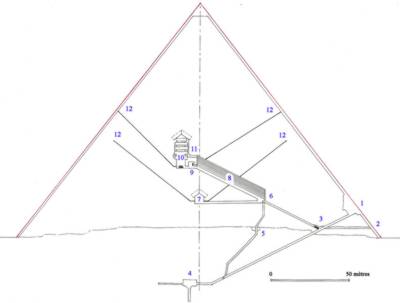 |
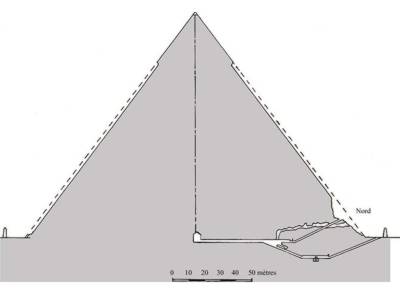 |
| Cairo |
After Giza we took the taxi back to our hotel, and the love we felt for Greece, Israel, and Jordan came to be felt as well for
Billy and I had a McDonald's dinner (he was craving Western food), and then took a taxi to
| World Heritage Site | ||||||||||||||||||||||||||||||||||||||||||||||||||||||
|
||||||||||||||||||||||||||||||||||||||||||||||||||||||
Wandering Cairo, we found more than our fair share of that "unfamiliar familiar" thing that I crave. Even things as mundane as parking meters are different here: A yellow arm is raised manually from the street to block the car in place, and is lowered after the parking attendant is paid.
Parking Mechanism in Cairo |
And Khan al-Khalili was spectacular, and was easily as good as Jerusalem (and as good at separating me from my money); I find I really like the experience of shopping in a lively, crowded Middle Eastern
|
|
Cairo is impossible to summarize; all you can get are fleeting perceptions, which assembled over the course of a lifetime, may assemble like a mental jigsaw puzzle into a piecemeal likeness of the whole. Here's what I can offer as the first few pieces of the puzzle: The transitions are stunning and instantaneous, from some of the oldest buildings in the world to shiny new construction; from uninhabitable desert to lush greenery; from donkeys and oxen on the street to blaring taxis zooming past them with mere inches to spare. Cairo has 16 million people, and is a teeming, thriving megalopolis with a lacework, three-dimensional street plan of bridges, tunnels, and roundabouts, and a populace that never completely stops shouting, yelling, honking, clanging, and calling to prayer – the latter over loudspeakers so amplified that they buzz when the muezzin stops to breathe. Silence and solitude cannot be found here, though the most humble do seem to find peace. It is Gotham City in Arabic. Cairo hits the five senses at once with its bright (vision), loud (hearing), and dusty (the other three) hub of activity that doesn't stop for nightfall, Fridays, or Ramadan. As a city, its unending clog of shops and souqs is the picture of vibrancy – but if it were a human, with blood instead of people pushing through its narrow capillaries, it would be very near to hypertensive, sclerotic death. The traffic lights are all permanently disabled, as no one would obey them anyway; sometimes there is a cop who can sometimes control the traffic. Cairo hired a Japanese firm in 2003 to advise on reducing congestion; after eighteen months of study they could not make a recommendation because their models all suggested the the population combined with the infrastructure should result in 24-hour gridlock. Crossing the street is not as bad as people say – you just have to start when there is a minor break in traffic, and keep moving deliberately; the cars may honk, may come within centimeters, may curse, may slam on their brakes for dramatic effect, but won't hit you.
| The Windsor Hotel |
 Our home for the night was the
Our home for the night was the
Lonely Planet also says that it has air conditioning in every room, but I can attest that room 12 doesn't have any. Nor (perhaps in balance to the air conditioning) does room 12 have hot water. But since it also doesn't have a toilet, we were accustomed to using the communal facilities on our floor, and – no worries – found hot water in the shower there.
|
|
| Main | ||||||||
| 20 | κʹ | |||||||
| 21 | καʹ | |||||||
| 22 | κβʹ | |||||||
| 23 | κγʹ | |||||||
| 24 | κδʹ | |||||||
| 25 | κεʹ | |||||||
| 26 | ח׳ | |||||||
| 27 | ט׳ | |||||||
| 28 | ١٠ | |||||||
| 29 | ١١ | |||||||
| 30 | ١٢ | |||||||
| 1 | ١٣ | |||||||
| 2 | ١٤ | |||||||
| 3 | Previous | الأخير | ١٥ | |||||
| 4 | ١٦ | |||||||
| 5 | Next | التالي | ١٧ | |||||
| 6 | ١٨ | |||||||



